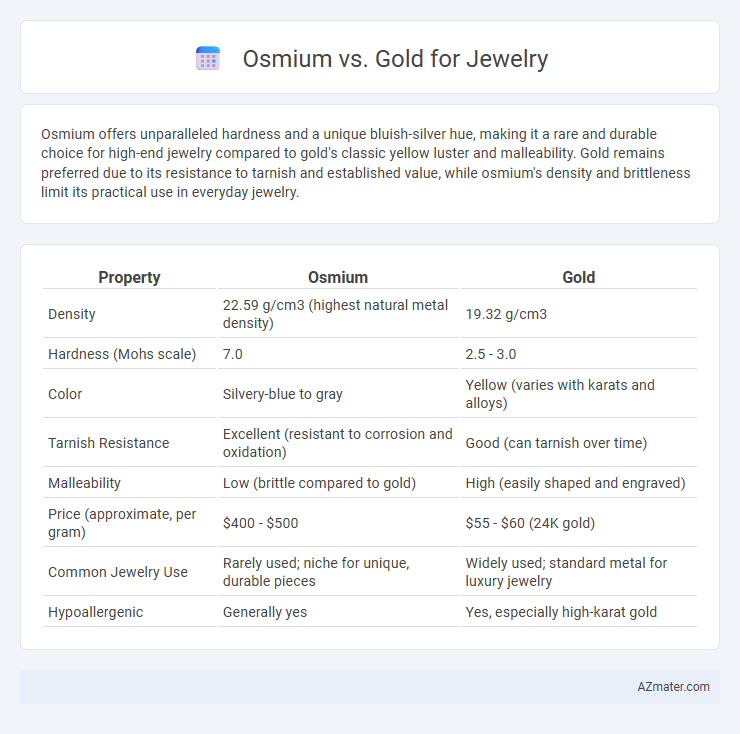Osmium offers unparalleled hardness and a unique bluish-silver hue, making it a rare and durable choice for high-end jewelry compared to gold's classic yellow luster and malleability. Gold remains preferred due to its resistance to tarnish and established value, while osmium's density and brittleness limit its practical use in everyday jewelry.
Table of Comparison
| Property | Osmium | Gold |
|---|---|---|
| Density | 22.59 g/cm3 (highest natural metal density) | 19.32 g/cm3 |
| Hardness (Mohs scale) | 7.0 | 2.5 - 3.0 |
| Color | Silvery-blue to gray | Yellow (varies with karats and alloys) |
| Tarnish Resistance | Excellent (resistant to corrosion and oxidation) | Good (can tarnish over time) |
| Malleability | Low (brittle compared to gold) | High (easily shaped and engraved) |
| Price (approximate, per gram) | $400 - $500 | $55 - $60 (24K gold) |
| Common Jewelry Use | Rarely used; niche for unique, durable pieces | Widely used; standard metal for luxury jewelry |
| Hypoallergenic | Generally yes | Yes, especially high-karat gold |
Understanding Osmium and Gold: Key Differences
Osmium and gold differ significantly in density, with osmium being one of the densest naturally occurring metals, approximately 22.59 g/cm3 compared to gold's 19.32 g/cm3, making osmium exceptionally heavy for its size in jewelry applications. Gold is renowned for its malleability, corrosion resistance, and warm yellow hue, while osmium is hard, brittle, and exhibits a bluish-silver color that oxidizes readily unless alloyed or coated. These properties influence durability, workability, and aesthetic appeal, positioning gold as a traditional jewelry choice and osmium as a niche option for unique, limited-edition pieces.
Physical Properties: Osmium vs Gold
Osmium boasts a remarkable density of 22.59 g/cm3, making it much heavier than gold, which has a density of 19.32 g/cm3, contributing to its exceptional weight in jewelry. While gold is prized for its malleability and ductility, osmium's hardness (around 7 on the Mohs scale) offers superior scratch resistance but also makes it more brittle and challenging to work with in intricate jewelry designs. The distinct bluish-silver hue of osmium contrasts with gold's warm yellow tone, affecting aesthetic choices for jewelry pieces.
Rarity and Availability in the Market
Osmium is one of the rarest elements on Earth, significantly rarer than gold, with an annual global production measured in only tens of kilograms compared to gold's thousands of tons. Its scarcity and the complexity of refining osmium into a stable form suitable for jewelry make it less available and more expensive for commercial use. Gold remains more widely accessible and tradable in the market, maintaining steady demand due to its malleability, timeless appeal, and established supply chains.
Durability and Wearability for Jewelry
Osmium is one of the densest and hardest metals, offering exceptional durability and resistance to scratches, making it highly suitable for long-lasting jewelry. Gold, while softer and more malleable, provides excellent wearability and traditional appeal with options for alloying to enhance strength. The choice between osmium and gold depends on the desired balance between maximum hardness and classic elegance in jewelry design.
Hypoallergenic Qualities of Both Metals
Osmium and gold exhibit distinct hypoallergenic properties important for jewelry wearers with sensitive skin. Osmium is highly resistant to tarnish and corrosion, minimizing skin irritation and allergic reactions, while pure gold (24K) is naturally hypoallergenic but often alloyed with metals like nickel that can cause allergies. Choosing high-purity gold or osmium jewelry ensures reduced risk of dermatitis and enhances comfort for individuals prone to metal allergies.
Aesthetic Appeal and Color Comparison
Osmium offers a unique silvery-blue hue with a metallic luster, creating a modern and distinctive aesthetic compared to gold's classic warm yellow tones. Gold is prized for its rich color variations, including yellow, white, and rose gold, allowing versatile design options that appeal to traditional and contemporary tastes. The vibrant shine of gold enhances its luxurious appearance, while osmium's subtle sheen attracts those seeking rare and unconventional jewelry finishes.
Pricing and Investment Value
Osmium jewelry commands higher prices than gold due to its rarity and extreme density, making it a unique choice for collectors and investors seeking exclusivity. Gold maintains steady investment value with widespread market liquidity and well-established demand, while osmium's niche appeal may offer greater appreciation potential but comes with limited resale markets. Price volatility in osmium suggests careful consideration for investment compared to gold's historically stable performance in the precious metals sector.
Environmental Impact of Mining
Osmium mining has a significantly lower environmental impact compared to gold due to its rarity and the smaller quantities required for jewelry, which reduces land disruption and resource depletion. Gold mining often involves cyanide leaching and mercury usage, resulting in hazardous waste and substantial water contamination. Choosing osmium over gold for jewelry supports more sustainable practices by minimizing chemical pollution and preserving ecosystems.
Popular Jewelry Uses and Design Trends
Osmium's rising popularity in jewelry stems from its striking bluish-silver hue and exceptional durability, making it ideal for modern, avant-garde designs. Gold remains the classic choice, favored for its warm tones and versatility in traditional and contemporary pieces, especially in engagement rings and necklaces. Current design trends emphasize mixed metals and minimalist styles, with osmium often paired with gold to create unique contrast and highlight its rarity.
Making the Right Choice: Osmium or Gold?
Osmium offers unmatched density and durability, making it ideal for those seeking jewelry with a unique, highly scratch-resistant finish, while gold remains a classic choice prized for its malleability and timeless luster. When deciding between osmium and gold, consider factors such as osmium's rarity and bluish-silver hue versus gold's various karat grades and yellow to rose color options. Choosing the right metal depends on personal style preferences, budget, and desired metal properties like weight, hypoallergenic qualities, and maintenance needs.

Infographic: Osmium vs Gold for Jewelry
 azmater.com
azmater.com